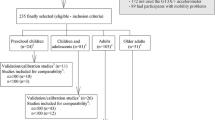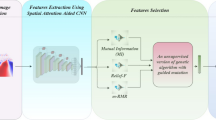Abstract
Obesity is becoming one of the serious problems for the health of worldwide population. Social interactions on mobile phones and computers via internet through social e-networks are one of the major causes of lack of physical activities. For the health specialist, it is important to track the record of physical activities of the obese or overweight patients to supervise weight loss control. In this study, acceleration sensor present in the smartphone is used to monitor the physical activity of the user. Physical activities including Walking, Jogging, Sitting, Standing, Walking upstairs and Walking downstairs are classified. Time domain features are extracted from the acceleration data recorded by smartphone during different physical activities. Time and space complexity of the whole framework is done by optimal feature subset selection and pruning of instances. Classification results of six physical activities are reported in this paper. Using simple time domain features, 99 % classification accuracy is achieved. Furthermore, attributes subset selection is used to remove the redundant features and to minimize the time complexity of the algorithm. A subset of 30 features produced more than 98 % classification accuracy for the six physical activities.


Similar content being viewed by others
References
W.H.O. Obesity and overweight. Fact Sheets 2013 [cited 2014 March 13]; Available from: http://www.who.int/mediacentre/factsheets/fs311/en/.
Abdullah, A., et al., The number of years lived with obesity and the risk of all-cause and cause-specific mortality. International journal of epidemiology 40(4):985–996, 2011.
Villareal, D. T., et al., Weight loss, exercise, or both and physical function in obese older adults. New England Journal of Medicine 364(13):1218–1229, 2011.
Foster Schubert, K. E., et al., Effect of Diet and Exercise, Alone or Combined, on Weight and Body Composition in Overweight‐to‐Obese Postmenopausal Women. Obesity 20(8):1628–1638, 2012.
Forster, M., et al., Cost-effectiveness of diet and exercise interventions to reduce overweight and obesity. International Journal of Obesity 35(8):1071–1078, 2011.
Consortium, I., Validity of a short questionnaire to assess physical activity in 10 European countries. European journal of epidemiology 27(1):15, 2012.
Wareham, N. J., et al., Validity and repeatability of a simple index derived from the short physical activity questionnaire used in the European Prospective Investigation into Cancer and Nutrition (EPIC) study. Public health nutrition 6(04):407–413, 2003.
Wen, C. P., et al., Minimum amount of physical activity for reduced mortality and extended life expectancy: a prospective cohort study. The Lancet 378(9798):1244–1253, 2011.
Corder, K., et al., Assessment of physical activity in youth. Journal of Applied Physiology 105(3):977–987, 2008.
Tudor-Locke, C., et al., Utility of pedometers for assessing physical activity. Sports Medicine 32(12):795–808, 2002.
Schneider, P. L., Crouter, S. E., and Bassett, D. R., Pedometer measures of free-living physical activity: comparison of 13 models. Medicine and Science in Sports and Exercise 36(2):331–335, 2004.
Chen, K. Y., and Bassett, D. R., The technology of accelerometry-based activity monitors: current and future. Medicine and science in sports and exercise 37(11):S490, 2005.
Ibata, Y., et al. Measurement of three-dimensional posture and trajectory of lower body during standing long jumping utilizing body-mounted sensors. in Engineering in Medicine and Biology Society (EMBC), 2013 35th Annual International Conference of the IEEE. 2013. IEEE.
Ohtaki, Y., et al., Recognition of daily ambulatory movements utilizing accelerometer and barometer. Power 100:102, 2004.
Khan, M., et al. A feature extraction method for realtime human activity recognition on cell phones. in Proceedings of 3rd International Symposium on Quality of Life Technology (isQoLT 2011). Toronto, Canada. 2011
Mathie, M. J., et al., Accelerometry: providing an integrated, practical method for long-term, ambulatory monitoring of human movement. Physiological measurement 25(2):R1, 2004.
Parkka, J., et al., Activity classification using realistic data from wearable sensors. Information Technology in Biomedicine, IEEE Transactions on 10(1):119–128, 2006.
Mathie, M., et al., Classification of basic daily movements using a triaxial accelerometer. Medical and Biological Engineering and Computing 42(5):679–687, 2004.
Sekine, M., et al., Classification of waist-acceleration signals in a continuous walking record. Medical engineering & physics 22(4):285–291, 2000.
Bao, L. and S.S. Intille, Activity recognition from user-annotated acceleration data, in Pervasive computing. 2004, Springer. p. 1–17.
Maurer, U., et al. Activity recognition and monitoring using multiple sensors on different body positions. in Wearable and Implantable Body Sensor Networks, 2006. BSN 2006. International Workshop on. 2006. IEEE.
Ermes, M., et al., Detection of daily activities and sports with wearable sensors in controlled and uncontrolled conditions. Information Technology in Biomedicine, IEEE Transactions on 12(1):20–26, 2008.
Lee, Y.-S. and S.-B. Cho, Activity recognition using hierarchical hidden markov models on a smartphone with 3D accelerometer, in Hybrid Artificial Intelligent Systems. 2011, Springer. p. 460–467.
Bonomi, A. G., et al., Detection of type, duration, and intensity of physical activity using an accelerometer. Med Sci Sports Exerc 41(9):1770–1777, 2009.
Allen, F. R., et al., Classification of a known sequence of motions and postures from accelerometry data using adapted Gaussian mixture models. Physiological Measurement 27(10):935, 2006.
Karantonis, D. M., et al., Implementation of a real-time human movement classifier using a triaxial accelerometer for ambulatory monitoring. Information Technology in Biomedicine, IEEE Transactions on 10(1):156–167, 2006.
Jin, G., Lee, S., and Lee, T., Context Awareness of Human Motion States Using Accelerometer. Journal of Medical Systems 32(2):93–100, 2008.
Lee, J.-A., et al., Portable Activity Monitoring System for Temporal Parameters of Gait Cycles. Journal of Medical Systems 34(5):959–966, 2010.
Yu, M., et al., Development of Abnormal Gait Detection and Vibratory Stimulation System on Lower Limbs to Improve Gait Stability. Journal of Medical Systems 34(5):787–797, 2010.
Wu, W., et al., Classification accuracies of physical activities using smartphone motion sensors. Journal of medical Internet research, 2012. 14 (5).
Anguita, D., et al., Human activity recognition on smartphones using a multiclass hardware-friendly support vector machine, in Ambient Assisted Living and Home Care. 2012, Springer. p. 216–223.
Kaghyan, S. and H. Sarukhanyan, Activity Recognition Using K-Nearest Neighbor Algorithm on Smartphone with Tri-axial Accelerometer. International Journal of Informatics Models and Analysis (IJIMA), ITHEA International Scientific Society, Bulgaria, 2012: p. 146–156
Mitchell, E., Monaghan, D., and O’Connor, N. E., Classification of sporting activities using smartphone accelerometers. Sensors 13(4):5317–5337, 2013.
Kwapisz, J. R., Weiss, G. M., and Moore, S. A., Activity recognition using cell phone accelerometers. ACM SigKDD Explorations Newsletter 12(2):74–82, 2011.
Hamalainen, W., et al. Jerk-based feature extraction for robust activity recognition from acceleration data. in Intelligent Systems Design and Applications (ISDA), 2011 11th International Conference on. 2011. IEEE.
Hall, M.A., Correlation-based feature selection for machine learning. 1999, The University of Waikato.
Hall, M.A. and L.A. Smith. Feature Selection for Machine Learning: Comparing a Correlation-Based Filter Approach to the Wrapper. in FLAIRS Conference. 1999.
Garcıa López, F., et al., Solving feature subset selection problem by a parallel scatter search. European Journal of Operational Research, 2006. 169 (2): p. 477–489.
Marti, R., Laguna, M., and Glover, F., Principles of scatter search. European Journal of Operational Research 169(2):359–372, 2006.
Hall, M. A., and Holmes, G., Benchmarking attribute selection techniques for discrete class data mining. Knowledge and Data Engineering, IEEE Transactions on 15(6):1437–1447, 2003.
Gutlein, M., et al. Large-scale attribute selection using wrappers. in Computational Intelligence and Data Mining, 2009. CIDM’09. IEEE Symposium on. 2009. IEEE.
Aha, D. W., Kibler, D., and Albert, M. K., Instance-based learning algorithms. Machine learning 6(1):37–66, 1991.
Breiman, L., Random forests. Machine learning 45(1):5–32, 2001.
Prasad, A. M., Iverson, L. R., and Liaw, A., Newer classification and regression tree techniques: bagging and random forests for ecological prediction. Ecosystems 9(2):181–199, 2006.
Al-Allak, A., Bertelli, G., and Lewis, P., Random forests: The new generation of machine learning algorithms to predict survival in breast cancer. International Journal of Surgery 11(8):607–607, 2013.
Biau, G., Analysis of a random forests model. The Journal of Machine Learning Research 98888(1):1063–1095, 2012.
Rodriguez, J. J., Kuncheva, L. I., and Alonso, C. J., Rotation forest: A new classifier ensemble method. Pattern Analysis and Machine Intelligence, IEEE Transactions on 28(10):1619–1630, 2006.
Kuncheva, L.I. and J.J. Rodríguez, An experimental study on rotation forest ensembles, in Multiple Classifier Systems. 2007, Springer. p. 459–468.
Hall, M., et al., The WEKA data mining software: an update. ACM SIGKDD explorations newsletter 11(1):10–18, 2009.
Lester, J., T. Choudhury, and G. Borriello, A practical approach to recognizing physical activities, in Pervasive Computing. 2006, Springer. p. 1–16.
Quinlan, J.R., C4. 5: programs for machine learning. Vol. 1. 1993: Morgan kaufmann.
Zhang, B., and Srihari, S. N., Fast k-nearest neighbor classification using cluster-based trees. Pattern Analysis and Machine Intelligence, IEEE Transactions on 26(4):525–528, 2004.
Angiulli, F., Fast nearest neighbor condensation for large data sets classification. Knowledge and Data Engineering, IEEE Transactions on 19(11):1450–1464, 2007.
Wilson, D. R., and Martinez, T. R., Reduction techniques for instance-based learning algorithms. Machine learning 38(3):257–286, 2000.
Arif, M., Malagore, I. A., and Afsar, F. A., Detection and localization of myocardial infarction using K-nearest neighbor classifier. Journal of medical systems 36(1):279–289, 2012.
Sun, L., et al., Activity recognition on an accelerometer embedded mobile phone with varying positions and orientations, in Ubiquitous intelligence and computing. 2010, Springer. p. 548–562.
Allen, F.R., et al. An adapted gaussian mixture model approach to accelerometry-based movement classification using time-domain features. in Engineering in Medicine and Biology Society, 2006. EMBS’06. 28th Annual International Conference of the IEEE. 2006. IEEE.
Mi-hee Lee, J. K., Kwangsoo Kim. Inho Lee, Sun Ha Jee, Sun Kook Yoo. Physical activity recognition using a single tri-axis accelerometer. in Proceedings of the world congress on engineering and computer science, 2009.
Kästner, M., et al. A Sparse Kernelized Matrix Learning Vector Quantization Model for Human Activity Recognition. in European Symposium on Artificial Neural Networks, Computational Intelligence and Machine Learning (ESANN). 2013.
Acknowledgement
This research was supported by the NSTIP strategic technologies program (12-INF2290-10) in the Kingdom of Saudi Arabia.
Author information
Authors and Affiliations
Corresponding author
Additional information
This article is part of the Topical Collection on Mobile Systems
Rights and permissions
About this article
Cite this article
Arif, M., Bilal, M., Kattan, A. et al. Better Physical Activity Classification using Smartphone Acceleration Sensor. J Med Syst 38, 95 (2014). https://doi.org/10.1007/s10916-014-0095-0
Received:
Accepted:
Published:
DOI: https://doi.org/10.1007/s10916-014-0095-0




